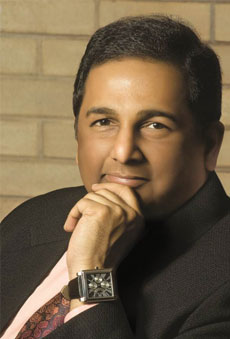Eyes lined with kajal, eye liner and mascara, a smile that is accompanied by a bright lipstick and hair that is glossy from the straightening procedures – that is how the face of the average young urban woman on the street looks. You think men are far behind? Well, check out the branded t-shirt of the young man walking past you, his stylish goggles and how can you miss those expensive shoes?
With rising purchasing power, the style quotient in urban India has gone up. Young and old, everyone wants to look their best and why not? Sold on the images of beauty beamed at them every day from everywhere, everyone wants to look their best.
But even to the untrained eye, there is an eerie similarity between the way people dress in New York, London, Paris and New Delhi. With rising purchasing power among the people, brands too are responding by expanding to new markets. Mumbai alone has dozens of shopping malls. But it is not the local handicrafts selling by the dozen, but expensive designer wear imported from abroad that is catching the eye of the fashionable.
Trends followed blindly
So what is fashion for an average Indian? “It is a temporary trend that a few people start and others follow. Most of the people who I know blindly follow trends without giving a thought to what compliments them,” says 25-year-old MBA student Siddharth Iyengar.

Aping the West, are we?
So that brings us to the next logical question. In the quest for ‘beauty’ and being fashionable, are we simply aping the West and losing our individuality? India after all has always had a rich textile and handloom industry, several ayurveda based products to enhance beauty, and emphasis on a balanced diet for good health. So why are we becoming just copycats?
“There is nothing wrong in trying to ape the popular culture because that is one way you discover yourself and your personal style,” feels Gia Kashyap whose blog Giasaysthat is followed by thousands of young adults. She adds, “However, to stand out from the crowd it is always nice to have an individualistic style.”
The fashion scene in the country is no longer gender specific. Men are increasingly focusing on looking good and grooming as much as women. Salons and spas catering to men are mushrooming across the country and the occasional haircut is no longer enough. Iyengar agrees that men his age are more concerned about their looks than ever before. “Men tend to copy western fashion rather than be innovative,” he adds.
It is not just make up and haircut. Beauty today is an industry that caters to every need of an individual. Aroma theraphy, reflexology, hot stone therapy are names of just some of the oil massages available in the market. It doesn’t end there of course. There are facials and body wraps, full body scrub and skin lightening procedures for those interested. Beauty is a big and booming business. And why should it not be, asks Dr Apoorva Shah of Richfeel – The D-tox Spa. “The desire to look good is increasing every day and people are becoming more conscious of their self-image, prestige and confidence.”
The supply is simply there to cater to the growing demand. Richfeel spa alone has over 350 members between the ages of 20 and 75!
Fix that smile, boost that confidence
When you are fixing everything from head to toe, how can you forget about those pearly whites? While doctors say that no dental procedures are unnecessary, patients are going that extra mile for the perfect smile. Some are even going as far as to fix a diamond on their front teeth to get that brilliant smile! Dr. Aniket Namdeowar, Prosthodontics and Implantology specialist, lists dental jewellery, smile designing and implants as some of the things his patients are taking a keen interest in. “Today, people are conscious about aesthetics and there is nothing wrong with that as everyone has the right to look good. Just as we go to the gym for health and follow the latest fashion trends to ensure that our appearance is perfect, a good smile adds to a person’s personality,” Dr. Namdeowar says.
Looking presentable has become extremely important in modern day society and work life but while adults can understand where to draw the line, the young are the most gullible. Billboards with airbrushed images, and stick thin models give them a distorted sense of what beauty should be. So what can parents do about it?
Focus on building the soul, not skin
“Parents are competing against jingles on the TV,” says Mumbai-based psychiatrist Dr. Harish Shetty. “In a globalised world which moves at a very fast pace, it is difficult to find the time to explore one-self internally. Hence people focus more on external factors. How you look defines how you feel,” he explains.

Looking for quick solutions
Dr. Nilesh Goyal, Cosmetic Dermatologist & Hair Specialist at Bombay Hospital says there are times when people come to him to ask him to fix a fold of fat on their tummy or make a small mole go away. He says, “We have to convince them at times that these procedures are not needed. Some of the problems are due to their lifestyle which they don’t want to correct.” He believes that people at times lose track of what beauty is and that intervention is required, only when there is a drastic abnormality.
Pressure on young children at times comes not just from the messages that the media relays, but also from their parents. Dr. Goyal shares a few instances when parents have brought their young children to him. “I have mothers who bring their 14-year-old sons because they have become dark playing in the sun. I tell them to let the children be!”
There are a rising number of salons that have popped up to cater to the grooming demands for children. They are given fancy hair-cuts and spa treatments and events are hosted for their little friends at several of these places. There is no dearth of parents wanting to spend their money to make their little ones happy.
Media to blame?
While most of the ire is directed at the media for sending out wrong messages, not everyone agrees with the argument. Gia believes that individuals have to use their own discretion as well. “Media plays an important role in influencing the youth. However, we cannot blame media for everything that is wrong, as it is also important for people to filter out information that’s provided to them,” she says.
Meanwhile, as the latest Fogg commercial on the TV becomes a rage, it is time to ask yourself what is important to you rather than following the herd.

